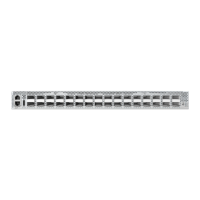C
HAPTER
41
| CFM Commands
Fault Generator Operations
– 1355 –
mep fault-notify
lowest-priority
This command sets the lowest priority defect that is allowed to generate a
fault alarm. Use the no form to restore the default setting.
SYNTAX
mep fault-notify lowest-priority priority
no fault-notify lowest-priority
priority – Lowest priority default allowed to generate a fault alarm.
(Range: 1-6)
DEFAULT SETTING
Priority level 2
COMMAND MODE
CFM Domain Configuration
COMMAND USAGE
◆ A fault alarm can generate an SNMP notification. It is issued when the
MEP fault notification generator state machine detects that a configured
time period (see the mep fault-notify alarm-time command) has passed
with one or more defects indicated, and fault alarms are enabled at or
above the priority level set by this command. The state machine
transmits no further fault alarms until it is reset by the passage of a
configured time period (see the mep fault-notify reset-time command)
without a defect indication. The normal procedure upon receiving a
fault alarm is to inspect the reporting MEP’s managed objects using an
appropriate SNMP software tool, diagnose the fault, correct it, re-
examine the MEP’s managed objects to see whether the MEP fault
notification generator state machine has been reset, and repeat those
steps until the fault is resolved.
◆ Only the highest priority defect currently detected is reported in the
fault alarm.
◆ Priority defects include the following items:
Table 183: Remote MEP Priority Levels
Priority Level Level Name Description
1 allDef All defects.
2 macRemErrXcon DefMACstatus, DefRemoteCCM, DefErrorCCM, or
DefXconCCM.
3 remErrXcon DefErrorCCM, DefXconCCM or DefRemoteCCM.
4 errXcon DefErrorCCM or DefXconCCM.
5xconDefXconCCM
6 noXcon No defects DefXconCCM or lower are to be
reported.

